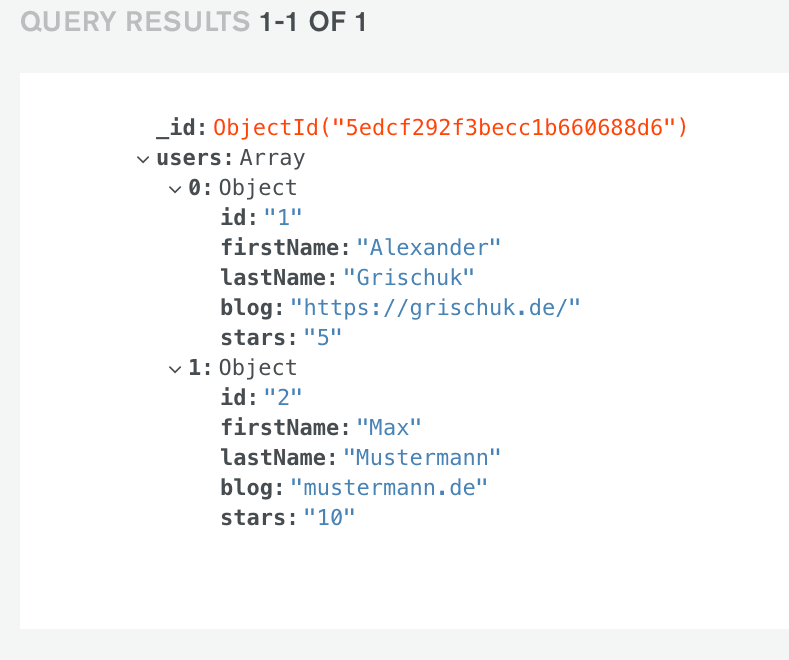Recently, I got an interest in working with a Next.js React Framework for server-side-rendered (SSR)applications (not only). I'm using Next more and more for my pet projects. I was surprised by how intuitive, easy, and enjoyable working with NextJS is.
In this article, we're going to setup GraphQL API with MongoDB connection for a NextJS app. I was surprised that both NextJS and Apollo GraphQL examples lacked such a common use case with MongoDB. There were examples with PostgreSQL but I wanted to use a non-SQL database. After spending some time learning and reading I put together this step-by-step guide on how to connect your Apollo Server GraphQL API to MongoDB and read/write data to Mongo database in your GraphQL resolvers.
Initialize a NextJS default app
There are multiple ways to initialize a project with Next via create-next-app similar to create-react-app or manually.
I'm going to use create-next-app with Yarn (alternatively, you could use NPM) for this example:
yarn create next-app graphql-apollo-mongodb
Pick a template › Default starter app
After dependencies are installed:
cd graphql-apollo-mongodb
yarn dev
Cool! Our NextJS app is running on http://localhost:3000.
Setting up MongoDB Atlas
MongoDB Atlas is the global cloud database service for modern applications. Deploy fully managed MongoDB across AWS, Azure, or GCP. Best-in-class automation and proven practices guarantee availability, scalability, and compliance with the most demanding data security and privacy standards. Use MongoDB's robust ecosystem of drivers, integrations, and tools to build faster and spend less time managing your database.
I'm going to be using an instance of the Cloud Mongo database.
- Navigate to the MongoDB Atlas page
- Click "Start Free" and sign up for the MongoDB account
- On the "Projects" page click on "New Project" give it a name and create
- Add Members. You're already a member -> hit continue
- Build Cluster -> Select Free Tier
- Select Cloud Provider & Region and Create Cluster
After the cluster is initialized click on "connect"
- Whitelist a connection IP address -> Add a Different IP Address -> Enter
0.0.0.0/0to the IP Address to access this DB from anywhere.
Create a MongoDB User -> Enter Username and Password
You'll be using this user to connect to the DB instance. Finally hit Create MongoDB User
Choose a connection method -> Select Connect Your Application and select Node.js
- Add your connection string to your application code
- Copy and save your application string
"mongodb+srv://test:<password>@cluster0-yvwjx.mongodb.net/<dbname>?retryWrites=true&w=majority"
Nice. We have a URL to the cloud DB instance to which we can connect from our code but we don't have a DB yet. Let's go and create a new DB.
Navigate to the Collections tab and click Add my Own Data
- Give DATABASE NAME/COLLECTION NAME and hit Create
After the setup you should see your cluster running:
We can insert some document/data into our database manually or via code execution. We are done here.
Setting up a GraphQL API with Apollo Server
Right now we don't have any graphql setup in our application. When we navigate to the http://localhost:3000/api/hello we'll see
{ "name": "John Doe" }
the output which is served from the pages/api/hello.js file.
What we need is to create a new endpoint under pages/api/graphql.js that's where our Apollo Server GraphQL setup will be located. Call to GraphQL API will be served from http://localhost:3000/api/graphql.
Install apollo-server-micro graphql mongodb
Let's install packaged required for the Apollo Server setup
yarn add apollo-server-micro graphql mongodb
Create a basic GraphQL server
Add graphql.js file under pages/api/.
// pages/api/graphql.js
import { ApolloServer, gql } from 'apollo-server-micro'
const typeDefs = gql`
type Query {
sayHello: String
}
`
const resolvers = {
Query: {
sayHello(parent, args, context) {
return 'Hello World!'
},
},
}
export const config = {
api: {
bodyParser: false,
},
}
const apolloServer = new ApolloServer({ typeDefs, resolvers })
export default apolloServer.createHandler({ path: '/api/graphql' })
We created a new instance of the ApolloServer, passing our type definitions and resolvers to it and serving this graphql on /api/graphql path.
When you navigate to the http://localhost:3000/api/graphql you should see a GraphQL Playground where you could execute mutation/queries.
That's great but our API doesn't do much for the moment. It was just for testing. Let's add a MongoDB connection.
Adding MongoDB connection to our Apollo Server
Before adding a MongoDB connection let's talk about data. For the example purpose our application will be displaying a list of users from MongoDB.
Here's my data representation:
{
"users": [
{
"id": 1,
"firstName": "Alexander",
"lastName": "Grischuk",
"blog": "https://grischuk.de/",
"stars": 5
},
{
"id": 2,
"firstName": "Max",
"lastName": "Mustermann",
"blog": "mustermann.de",
"stars": 3
}
]
}
I'll insert it manually into the MongoDB:
Creating executable schema and connecting mongo client to DB
Graphql schema is a combination of typeDefs and resolvers.
To make schema executable we need to install graphql-tools
yarn add graphql-tools
Let's describe a data query in our typeDefs and resolvers. We want to query a list of users from the MongoDB.
// pages/api/graphql.js
import { ApolloServer, gql } from 'apollo-server-micro'
import { makeExecutableSchema } from 'graphql-tools'
import { MongoClient } from 'mongodb'
const typeDefs = gql`
type User {
id: ID!
firstName: String!
lastName: String!
blog: String
stars: Int
}
type Query {
users: [User]!
}
`
const resolvers = {
Query: {
users(_parent, _args, _context, _info) {
return _context.db
.collection('users')
.findOne()
.then((data) => {
return data.users
})
},
},
}
const schema = makeExecutableSchema({
typeDefs,
resolvers,
})
let db
const apolloServer = new ApolloServer({
schema,
context: async () => {
if (!db) {
try {
const dbClient = new MongoClient(
'mongodb+srv://test:qwerty123@cluster0-yvwjx.mongodb.net/next-graphql?retryWrites=true&w=majority',
{
useNewUrlParser: true,
useUnifiedTopology: true,
}
)
if (!dbClient.isConnected()) await dbClient.connect()
db = dbClient.db('next-graphql') // database name
} catch (e) {
console.log('--->error while connecting with graphql context (db)', e)
}
}
return { db }
},
})
export const config = {
api: {
bodyParser: false,
},
}
export default apolloServer.createHandler({ path: '/api/graphql' })
Configuring .env variables
It's not recommended checking in your MongoDB URI directly to git for security and deployment convenience. We will make Mongodb URI accessible vie environment variables and pull it from there.
First, install dotenv npm package
yarn add dotenv
Create .env file at the project root with your MONGO_DB_URI
MONGO_DB_URI=mongodb+srv://test:qwerty123@cluster0-yvwjx.mongodb.net/next-graphql?retryWrites=true&w=majority
// pages/api/graphql.js
import { ApolloServer, gql } from 'apollo-server-micro'
import { makeExecutableSchema } from 'graphql-tools'
import { MongoClient } from 'mongodb'
require('dotenv').config()
const typeDefs = gql`
type User {
id: ID!
firstName: String!
lastName: String!
blog: String
stars: Int
}
type Query {
users: [User]!
}
`
const resolvers = {
Query: {
users(_parent, _args, _context, _info) {
return _context.db
.collection('users')
.findOne()
.then((data) => {
return data.users
})
},
},
}
const schema = makeExecutableSchema({
typeDefs,
resolvers,
})
let db
const apolloServer = new ApolloServer({
schema,
context: async () => {
if (!db) {
try {
const dbClient = new MongoClient(process.env.MONGO_DB_URI, {
useNewUrlParser: true,
useUnifiedTopology: true,
})
if (!dbClient.isConnected()) await dbClient.connect()
db = dbClient.db('next-graphql') // database name
} catch (e) {
console.log('--->error while connecting via graphql context (db)', e)
}
}
return { db }
},
})
export const config = {
api: {
bodyParser: false,
},
}
export default apolloServer.createHandler({ path: '/api/graphql' })
Testing GraphQL API with MongoDB connection in GraphQL Playground
Navigate to http://localhost:3000/api/graphql and make a query
{
users {
id
firstName
}
}
Query results from MongoDB connection:
In our MongoClient setup, we initialize a new database connection using new MongoClient() with MongoDB cloud URI read from our .env file. We return db object { db } from our context function to be accessible via _context in our resolvers. That's it! As soon as you have access to the database in your resolvers, you can perform read/write operations there for your queries and mutations.
graphql-apollo-mongodb-example
I created a supporting repository for this article so you can follow along commit-by-commit.















Top comments (0)